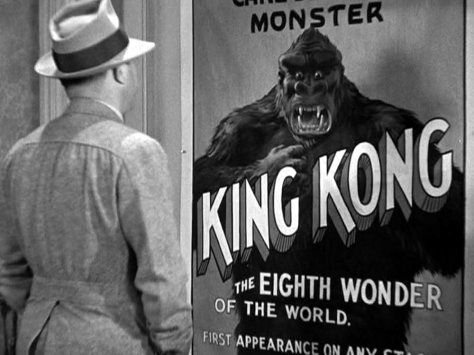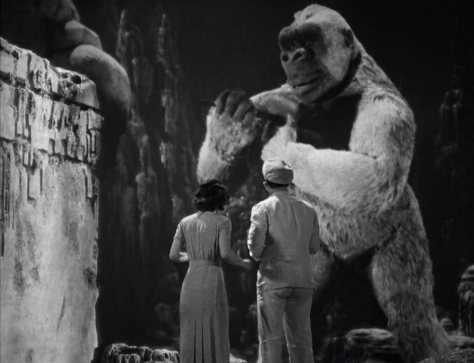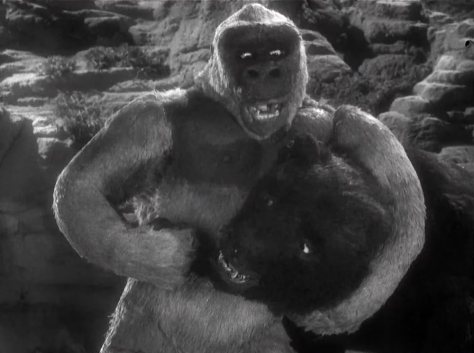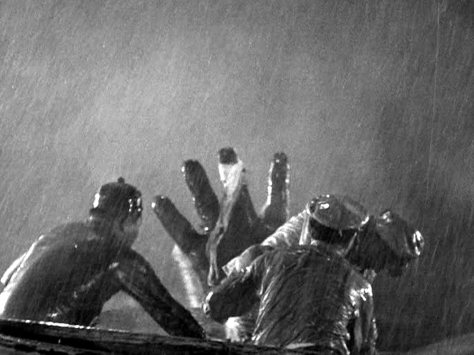
Released a mere nine months after the original King Kong in 1933 (this will post just two days shy of its eightieth anniversary), Son of Kong’s rapid turnaround leaves it in a bizarre place, a sequel that feels supplementary to what is probably the most important monster movie ever made. It has never been a particularly beloved movie, and despite the involvement of all the key people behind the scenes of the original—producer Merian C. Cooper, director Ernest Schoedsack, screenwriter Ruth Rose, and stop motion artist Willis O’Brien and his crew—one can detect how the rapidity of its creation rendered it a half-formed footnote (only sixty-nine minutes in length) even when it was new. King Kong inspired multiple generations of monster fans and left an entire form of storytelling in its wake—Son of Kong, not so much.
That hasn’t stopped me from being fascinated by this movie, because for all the ways it will forever toil under the shadow of its predecessor, it is historically important in several low-key ways, representing a major shift in the evolution of both King Kong and of monster movies as an idea: it is the point where the underlying sympathy for the monster comes to the surface. Now, this is a legacy that I’ve technically started writing about backwards, after I covered Mighty Joe Young last Christmas Apes season—that was the second movie by Cooper, Schoedsack, Rose, and O’Brien to take the sympathy they had built for Kong and rewrite it into a lighter story. As I argued there, this could come off as a commercial decision, but it also feels like a product of some phantom sense of guilt, and a desire to show that no matter how King Kong turned out, it is possible for humans and amazing creatures like Kong to co-exist peacefully, if they just got to know each other. What they would do with Mighty Joe Young begins in Son of Kong, but what’s particularly intriguing is, in the latter’s close proximity to the original Kong, it shows just how soon the original crew began to reconsider how a monster movie could operate.

If you were to go by what Ruth Rose said in interviews, the decisions they made with Son of Kong came from a realization that they would likely never top the original, so as her quote goes, “If you can’t it make bigger, make it funnier” (the smaller budget and short production schedule probably played a pretty big role in those decisions, though.) Don’t come in expecting the original film’s gravity and atmosphere, as this is a lighthearted romp that does not take itself seriously, right down to its loosey goosey construction. Certainly, the experience of watching Son of Kong sometimes feels like having someone list all their ideas for a King Kong sequel off the top of their head and than promptly leaving: subplots drop in and out without necessarily finding resolution, details are provided but left relatively unexplored, and in a movie as short as this, the titular ape child does not appear until halfway into it, leading to a rapidfire redux of the island sequence and its multiple dinosaur duels before the whole thing quite literally collapses. I wasn’t exaggerating by saying this feels like a supplement—in its brevity and its fairly loose addendum-style storytelling, it comes off like an extended epilogue for people who had nitpicking questions about the fallout of the original King Kong.

But that’s actually one of the things that, right off the bat, makes this seem like a surprisingly intelligent sequel set-up. Just like the movie release itself, the story takes place a short time after the ending of King Kong, and in a hilariously realistic fashion, wannabe film superstar Carl Denham (a returning Robert Armstrong, who also returned as a different-but-similar character in Mighty Joe Young) is being sued by everyone in New York for the property damage caused by Kong, forcing him to hide out in an obscure apartment, telling his kindly landlady to refuse all visitors so he can take a break from being served processes. Given how Kong established that massive amounts of urban destruction are a major part of giant monster movie, that Rose would think to show the inevitable legal repercussions in this sequel is kind of brilliant—in the final moment of the first movie, Denham seems to be left sad and regretful as the proper emotional conclusion to that story, but here we get to see that his troubles were only starting. After being served an indictment by the grand jury, he decides to take an offer from his equally beleaguered accomplice Captain Englehorn (Frank Reicher) to hop on his boat and hide out in the Pacific, chased out of the Big Apple for their Ape Escapade. Also returning, for no particular reason, is Charlie the cook (Victor Wong), always with a meat cleaver in hand—while probably another expression of budget constraints, having this film revolve around only one of the major characters from the original alongside two tertiary sidekicks makes for a strange follow-up. Clearly Ann Darrow and Jack Driscoll had much better things to do, or had better lawyers.

While stopping at Dutch port, Denham and the Gang bump into dishevelled drunk Nils Helstrom (John Marston)—and yes, that is basically same name as the fake scientist in The Hellstrom Chronicle, although I have not been able to confirm if that was an intentional reference in the later movie—the man who sold Denham the map to Kong’s island. Apparently, Helstrom was never concerned with big apes, as he asks Denham if he found the treasure of the island—and that suggestion is all Denham needs to decide that he could solve his monetary problems (but not any of his other legal problems) by finding the previously unmentioned treasure, and even convinces the reluctant Englehorn and Charlie to come along. Contrived? Yes. But it gets him back to the island, and that’s why you paid for the ticket.

Going back to Ann Darrow, another clear response to the story of the original Kong—which would also be refined further in Mighty Joe Young—is in its female lead. In this case, it’s Hilda (Helen Mack)—or possibly Helene, as the movie provides us with contradictory answers—who is unlike Darrow in two key ways: she’s already an entertainer, and she loves animals. She combines both loves in her failed circus performer father’s stage show, where her opening act is a costumed band of monkeys playing instruments and dancing (images that might be amusing or nightmarish depending on who you are) or a group of performing sea lions whose act we unfortunately don’t get to see. The reversals in the script get granular in other ways: Denham was the one who convinced Darrow to join his mystery voyage, while he actively attempts to dissuade Hilda from joining him this time, maybe because he wants to avoid potentially traumatizing another woman. She is clearly meant, in theory at least, to be a more proactive leading lady, someone who willingly joins the adventure and, more importantly, immediately sympathizes with the giant ape they encounter—on the other hand, her story here begins with Helstrom accidentally murdering her father in and burning her home to the ground in a drunken rage, so it’s not all smiles and sunshine. In any case, the writing here is self-aware and reacting to the first film, surprisingly even attempting to escape the original’s status as the premier “screaming woman kidnapped by monster” story.
(The scene where we see Hilda perform, with her interesting singing voice, also represents both this movie’s approach to comedy and its strange use of time—the repeated shots of the bemused audience is funny, but the fact that she does in fact sing a whole song is maybe a sign that the movie was looking for padding as much as it was looking for laughs.)

The set-up gets sillier as we inch ever closer to the appearance of a Kong—Helstrom convinces the crew of the ship to stage a worker’s revolt (and the dialogue makes it clear that these sailors are going full Bolshevik) that turns against him when he tries to claim the role of captain, and in their small lifeboat Denham expects to be greeted as a friend by the inhabitants of the island, only to realize that those islanders probably blame him for Kong bursting through their big door and smashing up their village. All of this leads to the moment where, on a previously unexplored side of the island, Denham and Hilda encounter a smaller, white-furred, less-threatening ape (referred to as Kiko during production and by fans), and help it out of quicksand, convincing it to stick around. The one with the most interesting reaction to this is Denham—repeatedly, he talks to the big little ape and compares him to his “old man”, and in these moments he openly expresses his sense of guilt over what he did to Kong, and in joining Hilda in helping the primate and accepting his presence, he is trying in some small way to atone for his thoughtless abuse of a natural wonder. Even through Armstrong’s boisterous for-the-backseats acting, one can detect the genuine sadness and regret when his character recounts the events of the previous movie.

With the Song of Kong finally here, we can see how the tonal shift has turned the (slightly less) giant monster into a straight figure of fun, with moments of physical comedy laced into the multiple fights against fiercer prehistoric monstrosities. Even the pacing of those fights reflects the new tone, with the grappling against a large bear and a serpentine dinosaur climaxing moments where the downed opponent gets up and attacks the unaware ape from behind—this Kong is not the master of his domain like Kong the Elder was. There is a light brashness and numerous pratfalls that are a stark contrast to the massive, earth-shaking death duels that defined the original Kong, which means the journey into land of ancient terrors feels almost whimsical rather than dread-inducing, and that is reflected in the much milder concern of our human cast during these moments as well.

At the same time, Willis O’Brien adapts to this change in tone pretty seamlessly—while Kongson, Son of Kong (created by altering one of the original Kong puppets) is intentionally cuter and sillier (and maybe by extension renders the other prehistoric critters less menacing), the animation remains top notch, retaining all the fluidity and energy from the original. He even takes to the comic approach by expanding the range of emotion and movement allowed for the smaller Kong—he is more expressive and full of unique little poses, giving him an exuberant personality. While you could argue that the loss of the original film’s overall power as a narrative is a major detriment to this, it allowed one of its major players to better show off the range he was capable of.

I have no idea if Cooper, Rose, and Schoedsack knew that King Kong was fast becoming a favourite among kids (some of whom would go on to become famous monster movie makers themselves), but Son of Kong sometimes feels like it was tailor-made for that part of the audience. The little Kong quickly establishes himself as the prototypical friendly monster, a creature that selflessly defends humans from nastier foes, which makes it feel like a precursor to the child-friendly direction taken on by 1960s kaiju like Gamera and even King Kong‘s spiritual-successor-turned-rival Godzilla. In that sense, this is a film that is way ahead of its time, and in a way that differentiates it from the much more grounded hero ape in Mighty Joe Young, a film that was animated by one of those Kong-loving kids.

In one final weird turn, the lighter tone of the movie does not, in fact, prevent it from becoming tragic, which firmly places it as the missing link between the tone of King Kong and Mighty Joe Young. The finale has the entire island struck by a simultaneous earthquake and typhoon—a deus ex machina contrivance in a movie full of them—leading to scenes of catastrophic destruction that probably would have benefited from the moments of panicked dinosaur stampedes that were planned but dropped for budget and time, so we’re left with only fleeting reminders of all the life that resides there. As the island sinks beneath the waves, wiping all traces of Kong’s amazing lost world from the map, the little Kong uses his final moments to hoist Denham into the lifeboat before going down with his home. Another Kong dies because of Denham—but of course, this time it’s a little different. To the end, Denham questions whether the ape was knowingly sacrificing himself to save him—still not quite capable of accepting the strange reality he willingly entered, or maybe still wracked with guilt—but Hilda is a steadfast believer in the little Kong’s heroism. Nine months after making audiences weep over a dead monkey, the same storytellers reaffirmed those emotions through their re-contextualization.
Review All Monsters will return in the new year.
